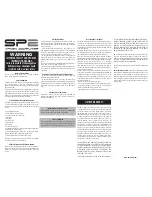
Model 4200A-SCS Parameter Analyzer Reference Manual
Section 5: Pulse measure and pulse generator units
4200A-901-01 Rev. C / February 2017
5-9
Control RPM switching
Before using an RPM, configure the 4200A-SCS by doing the steps in
(on page 7-10). This properly associates the instruments connected to each RPM.
There are two methods to control RPM switching:
•
ITM operation using automatic switching (after doing the steps in
(on page 7-10))
•
UTM testing from within the user module, use the LPT function
(on page 13-124)
You must update the RPM configuration in KCon before using the RPM to control switching. If you
do not, corrupt test data may result due to incorrect switch settings in the RPM.
Waveform capture
The maximum number of rows that can appear in the Analyze sheet for an ITM is 4096. Each
waveform sample uses one row of the sheet. Therefore, the number of samples acquired for a
waveform must fit within the 4096 points.
The number of samples (rows) for a waveform that is 20.48 µs wide is calculated as follows:
Number of samples (rows) = Sample rate x waveform width
= 200e6 x 20.48 µs
= 4096
If the waveform is any wider, the sample rate is automatically lowered by Clarius to fit the waveform
within the 4096 points.
Waveform width that is sampled includes pulse rise, pulse magnitude, pulse fall, and a small portion
of the base level before the rise and after the fall.
Connections
Proper connection methods are critical to perform stable and accurate measurements using the PMU
(with or without the RPM). It is also a good practice to apply these guidelines to all the Keithley
Instruments pulse cards to prevent pulse voltage overshoot and oscillations.
The following connection information is provided in this section:
•
Connection guidelines
•
Basic PMU connection schemes
•
Connections to prober or test fixture bulkhead connectors
•
Using an SMA to SSMC adapter cable to connect pulse card to DUT
•
4225-RPM connections
















































